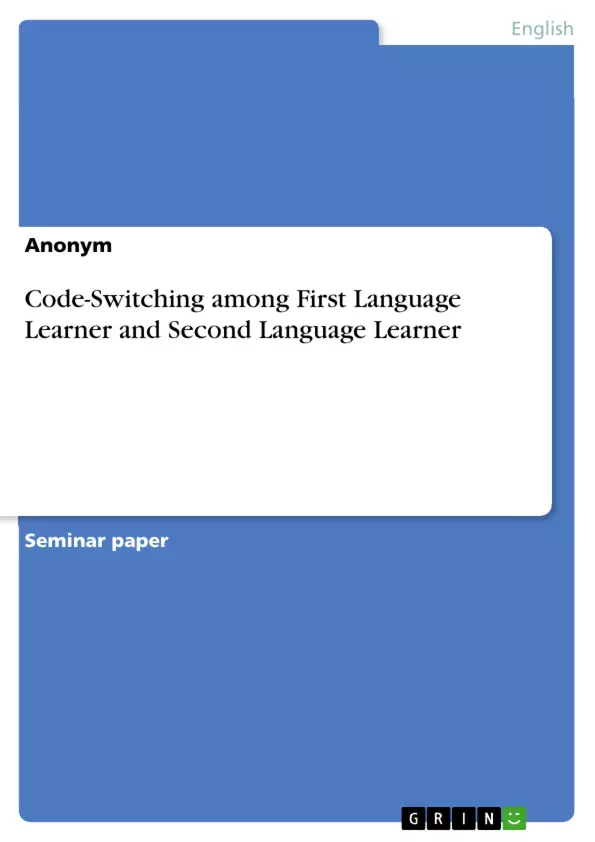How does another language influence Code-Switching and is there a difference between First Language learner and Second Language learner?
Employers of the German company Tchibo all got new contracts with English work titles. Fillialleiter are now called “store manager”, Bezirksleiter are now called “area manager”. Their functions stay the same, just the name changes. I am confused. I visit Japan and can understand a few words of their difficult language. Aisukurimu (“ice-cream”), biru (“beer”), of course I can understand them, it sounds just like the English words. Conversations on my New-Zealand bus tour are changing every few minutes. I hear French, Spanish and English, depending on whom they are talking to. When I visit my best friend, who has French parents, I hear them switching from French to German every few minutes, although they could just continue speaking one language. Why are they switching?
Code-Switching has become one of the most common language phenomena in these days. It started to attract the attention of more people, including linguists. This increased interest possibly arose from a more intense language contact in the industrialised world.
I hear Franglais, Spanglish, Tex-Mex, Denglish but in a rather negative way, people might have a negative attitude to the increase of Code-Switching, afraid of missing their culture.
Inhaltsverzeichnis (Table of Contents)
- Introduction
- Theoretical Background
- Definition
- Origin
- Reasons for Code-Switching
- Forms of Code-Switching
- Intra-sentential switching
- Inter-sentential Code-Switching
- Extra-sentential or Tag-switching
- Distinguish Code-Switching from other contact phenomena
- Code-Switching with First Language Learner and Second Language Learner
- Bilingualismus
- Code-Switching with Second Language Learner L2
- Conclusion
Zielsetzung und Themenschwerpunkte (Objectives and Key Themes)
This text aims to explore the phenomenon of code-switching, analyzing its definition, origins, reasons, and forms. It delves into the distinction between code-switching and related linguistic contact phenomena, and examines the specific implications of code-switching for first and second language learners.
- Definition and characteristics of code-switching
- Historical and linguistic origins of the term "code-switching"
- Reasons and functions of code-switching in communication
- Different forms of code-switching, including intra-sentential, inter-sentential, and tag-switching
- Comparison and distinction between code-switching and other contact phenomena like code-mixing and borrowing
Zusammenfassung der Kapitel (Chapter Summaries)
- Introduction: The introduction sets the stage for the discussion of code-switching by providing real-world examples of language mixing in various contexts. It highlights the increasing prevalence of code-switching in today's world and introduces key questions about its impact and influence on language and culture.
- Theoretical Background: This chapter defines code-switching as a phenomenon observed in bilingual speakers who effortlessly alternate between languages. It delves into the historical origins of the term "code-switching" and explores the concept of style-shifting in monolingual speakers as a parallel phenomenon. The chapter also discusses the reasons behind code-switching, attributing it to various functions such as inclusion, exclusion, expression, and reference. It touches upon the metalinguistic function of code-switching, where it serves to comment on the languages involved.
- Forms of Code-Switching: This chapter elaborates on different types of code-switching, including intra-sentential switching (within a sentence), inter-sentential switching (between sentences), and extra-sentential or tag-switching (inserting a tag from one language into another). It emphasizes that these variations require different levels of bilingual proficiency.
- Distinguish Code-Switching from other contact phenomena: This chapter differentiates code-switching from other related linguistic contact phenomena, such as code-mixing, which involves mixing elements from multiple languages within a single utterance without clear breaks. It further explains borrowing, the integration of elements from one language into another, focusing on lexical borrowing as a distinct phenomenon.
Schlüsselwörter (Keywords)
The main keywords and focus topics of this text include code-switching, bilingualism, language contact, linguistic repertoire, language shift, style-shifting, intra-sentential switching, inter-sentential switching, tag-switching, code-mixing, borrowing, and metalinguistic function.
- Quote paper
- Anonym (Author), 2020, Code-Switching among First Language Learner and Second Language Learner, Munich, GRIN Verlag, https://www.grin.com/document/1421436



